The Visionists were an informal social club based in Boston, Massachusetts in the late 19th century, focused on the members' shared interests in artists, writers, and cultural movements. Documented members included:
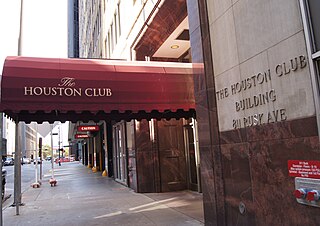
A social club may be a group of people or the place where they meet, generally formed around a common interest, occupation, or activity. Examples include: anime clubs, book discussion clubs, charity work, chess clubs, country clubs, criminal headquarters, final club, fishing club, gaming club, gentlemen's clubs, hunting clubs, military officers' clubs, politics clubs, science clubs, university clubs, Christian Fellowships. This article covers only three distinct types of social clubs: the historic gentlemen's clubs, the modern activities clubs, and an introduction to fraternities and sororities. This article does not cover a variety of other types of clubs having some social characteristics.
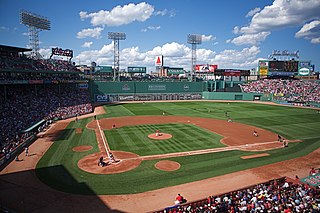
Boston is the capital and most populous city of the Commonwealth of Massachusetts in the United States, as well as the 21st most populous city in the United States. The city proper covers 48 square miles (124 km2) with an estimated population of 694,583 in 2018, making it also the most populous city in New England. Boston is the seat of Suffolk County as well, although the county government was disbanded on July 1, 1999. The city is the economic and cultural anchor of a substantially larger metropolitan area known as Greater Boston, a metropolitan statistical area (MSA) home to a census-estimated 4.8 million people in 2016 and ranking as the tenth-largest such area in the country. As a combined statistical area (CSA), this wider commuting region is home to some 8.2 million people, making it the sixth most populous in the United States.

Massachusetts, officially the Commonwealth of Massachusetts, is the most populous state in the New England region of the northeastern United States. It borders on the Atlantic Ocean to the east, the states of Connecticut and Rhode Island to the south, New Hampshire and Vermont to the north, and New York to the west. The state is named after the Massachusett tribe, which once inhabited the east side of the area, and is one of the original thirteen states. The capital of Massachusetts is Boston, which is also the most populous city in New England. Over 80% of Massachusetts' population lives in the Greater Boston metropolitan area, a region influential upon American history, academia, and industry. Originally dependent on agriculture, fishing and trade, Massachusetts was transformed into a manufacturing center during the Industrial Revolution. During the 20th century, Massachusetts's economy shifted from manufacturing to services. Modern Massachusetts is a global leader in biotechnology, engineering, higher education, finance, and maritime trade.
- Writer/architect Ralph Adams Cram
- Publisher/photographer F. Holland Day
- Designer/architect Bertram Grosvenor Goodhue
- Poet Bliss Carman
- Poet Richard Hovey
- Musician/composer Frederic Field Bullard
- Editor/Publisher/Entrepreneur Herbert Small (co-founder of the world's first public relations firm)
- Publisher Herbert Copeland
- Publisher/photographer Francis Watts Lee
- Illustrator/painter Thomas Buford Meteyard
- Playwright/actor John C. "Jack" Abbott
- Writer Jonathan Thayer Lincoln
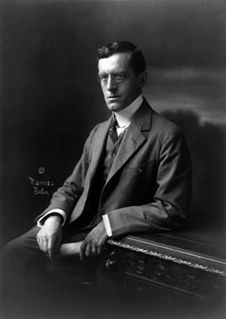
Ralph Adams Cram was a prolific and influential American architect of collegiate and ecclesiastical buildings, often in the Gothic Revival style. Cram & Ferguson and Cram, Goodhue & Ferguson are partnerships in which he worked. Together with an architect and artist, he is honored on December 16 as a feast day in the Episcopal Church of the United States. Cram was a fellow of the American Institute of Architects.
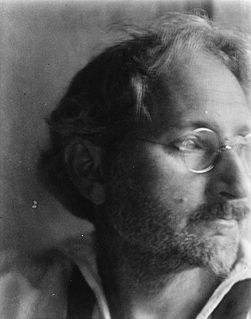
Fred Holland Day was an American photographer and publisher. He was the first in the United States to advocate that photography should be considered a fine art.

Bertram Grosvenor Goodhue was an American architect celebrated for his work in Gothic Revival and Spanish Colonial Revival design. He also designed notable typefaces, including Cheltenham and Merrymount for the Merrymount Press. Later in life, Goodhue freed his architectural style with works like El Fureidis in Montecito, one of the three estates designed by Goodhue.
Poet Louise Imogen Guiney and writer Alice Brown were close with this group and participated in at least some of their gatherings. Their extended circle of friends also included illustrator Ethel Reed, art historian Bernard Berenson, and poet Gelett Burgess.

Louise Imogen Guiney was an American poet, essayist and editor, born in Roxbury, Massachusetts.

Alice Brown was an American novelist, poet and playwright, best known as a writer of local color stories. She also contributed a chapter to the collaborative novel, The Whole Family (1908).

Ethel Reed was an internationally recognized American graphic artist. In the 1890s, her works received critical acclaim in America and Europe. In 2016 they were on exhibit in the Metropolitan Museum of Art and Museum of Modern Art in New York, the National Museum of American History in Washington, D.C., the Fine Arts Museums of San Francisco, the Frederick R. Weisman Art Museum of the University of Minnesota in Minneapolis, and the Nelson-Atkins Museum of Art in Kansas City.
According to Cram's autobiography, the Visionists were a "social-controversial-inspiration group" that never numbered more than twenty, made up of the "madder and more fantastic members" of a similar but larger group called "The Pewter Mugs". They held periodic meetings in their "hideout" on Boston's Province Court, as well as gatherings in suburban locations such as Day's house in Norwood, Massachusetts or a house shared by Thomas Buford Meteyard and his mother in Scituate, Massachusetts.
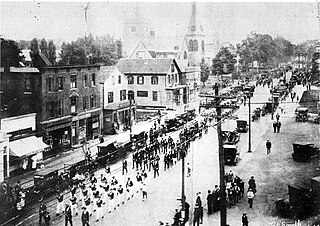
Norwood is a town and census-designated place in Norfolk County, Massachusetts, United States. Norwood is part of the Greater Boston area. As of the 2010 census, the population was 28,602. The town was named after Norwood, England. Norwood is on the Neponset River, which runs all the way to Boston Harbor from Foxborough.
The members' shared interests included medieval art and architecture, Aestheticism, the Decadent movement, Christian Socialism, the Arts and Crafts Movement, the Pre-Raphaelites, and Theosophy. Favorite writers and artists included Oscar Wilde, William Morris, John Ruskin, and Dante Gabriel Rossetti. From 1892-1893 the group edited a literary journal titled The Knight Errant, published by Francis Watts Lee.

The medieval art of the Western world covers a vast scope of time and place, over 1000 years of art in Europe, and at times the Middle East and North Africa. It includes major art movements and periods, national and regional art, genres, revivals, the artists' crafts, and the artists themselves.

Medieval architecture is architecture common in the Middle Ages, and includes religious, civil, and military buildings. Styles include pre-Romanesque, Romanesque, and Gothic. While most of the surviving medieval architecture is to be seen in churches and castles, examples of civic and domestic architecture can be found throughout Europe, in manor houses, town halls, almshouses, bridges, and residential houses.
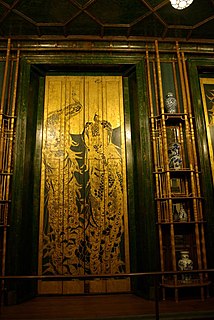
Aestheticism is an intellectual and art movement supporting the emphasis of aesthetic values more than social-political themes for literature, fine art, music and other arts. This meant that art from this particular movement focused more on being beautiful rather than having a deeper meaning — "art for art's sake". It was particularly prominent in Europe during the 19th century, supported by notable figures such as Walter Pater and Oscar Wilde, but contemporary critics are also associated with the movement, such as Harold Bloom, who has recently argued against projecting social and political ideology onto literary works, which he believes has been a growing problem in humanities departments over the 20th century.







